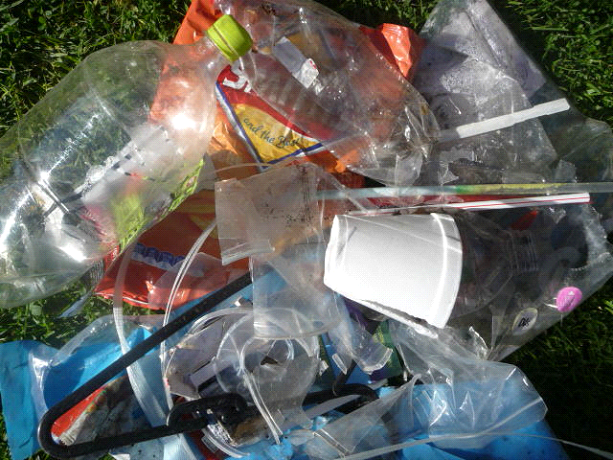New study backs Symphony’s d2w oxo-bio additive | Packaging News | Manufacture | Jobs | Design | Materials | Equipment
Posted on May 25, 2012 by DrRossH in Plastic Waste NewsI read these conclusions and my first impression was the author was really struggling to find good information. Who decides what ‘performed better’ meant? As Dr Williams said all the report data, test conditions should be made available for independent people to access it and publish some real comparative data, not just some ‘performed better’ statement.
There is no mention of how the test was done, was there any artificial pretreatment (heat aging) done on the oxo material? How was biodegradation accessed? Was it CO2 emissions, mass reduction, CH4 emissions?
We just have to ask, what advantages do oxo-degradable plastics offer? As the author states, 0.75% of plastic ends up as litter, yet they want to put oxo degradable additives in 100% of the plastic bags to cover the 0.75% that are littered? What about the other 99.25% that go to landfills or are reused. Oxo degradables serve no advantage for them at all. For the bags that are reused, oxodegradable is a disadvantage as the bag will fall to bits. The author proudly states that oxodegradable bags will not break down in a landfill and produce methane, a gas with high global warming potential. This is masking a bigger truth. What they are saying is that in a landfill the bags will not breakdown but behave just like any other conventional bag. So in this situation (where about 90+% of bags end up) oxodegradable has no advantage at all. As we, as a society with increasing natural resource pressures, go forwards, one of the better ways to get energy is the renewable energy from landfills, i.e. capture the methane and generate electricity from it. Combusting methane is a lot cleaner than combusting coal or oil, so over all collecting methane and generating electricity from that and displacing coal, could have less global warming effect. So we, in increasing numbers of places as people start to realise this, are wanting landfills to generate methane so it can be captured.
The use of biodegradable materials is a much better option for our consumable, or single use plastic items. First it ought to be banning disposable plastic items and using paper or reusable items then lastly if we have to use plastic for these situations make it biodegradable plastic that will biodegrade in a landfill. This will cater for the 90+% of plastic bags, not just the 0.75% of bags the author proudly states.

 How many people today grab a takeaway coffee cup from the local cafe to drink on the go? We don’t know, but the number must be enormous.. Most every one of the above have a plastic top that will last 100s of years. Some cafes still use plastic cups that last a similar time. Is 10 minutes of coffee worth 100s of years of trash?
These items can be seen littering our gutters and on our streets all over the place. If they were all cardboard, they would still be littered, but they would, at least, be gone in a short time.
They do not need to be made of plastic.
How many people today grab a takeaway coffee cup from the local cafe to drink on the go? We don’t know, but the number must be enormous.. Most every one of the above have a plastic top that will last 100s of years. Some cafes still use plastic cups that last a similar time. Is 10 minutes of coffee worth 100s of years of trash?
These items can be seen littering our gutters and on our streets all over the place. If they were all cardboard, they would still be littered, but they would, at least, be gone in a short time.
They do not need to be made of plastic.
 On the way home from the gym last week, a distance of about 1 km (1/2 mile), I counted the items of plastic litter on the curb as I walked. In that short distance I counted 63 pieces of plastic litter. Plastic drink bottles, bottle tops, candy wrappers, plastic film, polystyrene fragments etc. That seemed to be a lot to me. I guess it is a generational thing. Our parents would have been horrified to see that amount, whereas it seems to go unnoticed by our youth of today. In another 20 years how many pieces will there be on this stretch, -- 200? What will today’s youth think of that new amount then when they are older? Will their children be so readily accepting of a higher amount of litter?
On the way home from the gym last week, a distance of about 1 km (1/2 mile), I counted the items of plastic litter on the curb as I walked. In that short distance I counted 63 pieces of plastic litter. Plastic drink bottles, bottle tops, candy wrappers, plastic film, polystyrene fragments etc. That seemed to be a lot to me. I guess it is a generational thing. Our parents would have been horrified to see that amount, whereas it seems to go unnoticed by our youth of today. In another 20 years how many pieces will there be on this stretch, -- 200? What will today’s youth think of that new amount then when they are older? Will their children be so readily accepting of a higher amount of litter?
Discussion · No Comments
There are no responses to "New study backs Symphony’s d2w oxo-bio additive | Packaging News | Manufacture | Jobs | Design | Materials | Equipment". Comments are closed for this post.Oops! Sorry, comments are closed at this time. Please try again later.